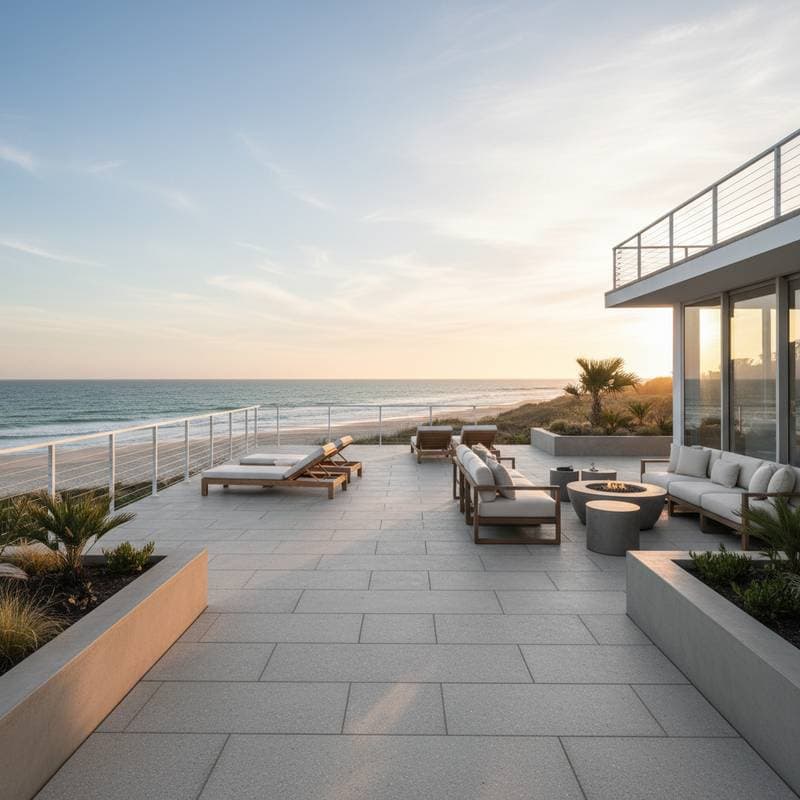9 Reasons Concrete Decking Excels for Beach House Owners
Beach house ownership offers the allure of ocean vistas, gentle waves, and leisurely seaside days. Coastal locations, however, impose unique demands on outdoor structures through persistent moisture, corrosive salt air, and unrelenting sunlight. Selecting decking that balances resilience, simplicity in upkeep, and visual charm proves essential.
Concrete decking stands as a proven choice for seaside properties, outperforming many alternatives in environmental resistance while allowing creative customization and fiscal prudence. Homeowners pondering its suitability for ocean-adjacent spaces find compelling justification in its performance. The following outlines nine compelling advantages of concrete decking and its capacity to enhance outdoor environments into enduring, hassle-free sanctuaries.
Strength and Durability in a Coastal Environment
1. Resistance to Salt and Moisture
Concrete endures prolonged contact with saltwater spray and high humidity inherent to beachfront settings. Wood alternatives succumb to rot, distortion, and pest infestation under similar conditions, while metals oxidize and weaken. Concrete maintains structural integrity without such vulnerabilities.
Pro Tip: Apply a premium penetrating sealer biennially to repel salt ingress and mitigate superficial fissures, ensuring a uniform appearance over years.### 5. Fluid Connection Across Outdoor Zones
Concrete facilitates unbroken expanses linking terraces, swimming areas, pathways, and entryways. This cohesive layout amplifies perceived scale and streamlines navigation.
Its moldable nature during pouring suits irregular contours, multi-level platforms, or integrated benches, surpassing the limitations of rigid panel systems.
6. Solid Foundation for Added Amenities
Concrete offers unwavering support for built-in elements like cooking stations, hearth installations, or shaded arbors. Secure these directly into the slab to prevent misalignment from substrate movement.
Pro Tip: In saline environments, pair with corrosion-resistant hardware and marine-grade composites to extend the lifespan of adjunct features.
Cost Efficiency and Environmental Benefits
7. Superior Long-Term Value
Upfront costs for concrete installation may exceed those of basic lumber or polymer composites by 20 to 30 percent. However, the absence of frequent interventions offsets this premium within five to seven years.
In corrosive coastal regions, concrete averts the escalating outlays for part replacements or full overhauls, securing a prudent return on investment.
8. Thermal Performance in Sunny Locales
Concrete's high thermal mass and light-reflective properties dissipate solar heat effectively, maintaining cooler contact temperatures. This benefit proves vital where direct sunlight renders alternative surfaces scalding.
Incorporate pale aggregates or solar-reflective topcoats to lower peak temperatures by up to 15 degrees Fahrenheit, enhancing usability during peak hours.
9. Eco-Conscious Material Selection
Modern concrete formulations integrate post-industrial byproducts like slag or reclaimed aggregates, curtailing landfill contributions. Its protracted durability curtails the demand for successive material cycles.
Pair with water-permeable variants and indigenous vegetation to foster biodiversity and manage stormwater runoff in sensitive coastal ecosystems.
Essential Considerations for Coastal Decking Projects
Select contractors experienced in marine-grade installations to navigate local soil shifts and wind loads. Specify sealants formulated for UV stability and chloride penetration resistance. Incorporate subtle slope gradients or integrated drains to shed rainwater efficiently.
Establish upkeep protocols with eco-friendly, non-abrasive solutions to safeguard both the deck and surrounding habitats.
[Image: Modern beach house with polished concrete deck and ocean view]
Frequently Asked Questions
Is concrete decking slippery when wet?
A textured finish, such as broom or exposed aggregate, delivers reliable footing. Many ornamental treatments incorporate silica sand or polymer additives for enhanced non-slip performance.
How often should concrete decking be sealed near the beach?
Resealing every two to three years suffices for moderate exposure, with annual inspections guiding adjustments. This routine blocks efflorescence and preserves vibrancy.
Can concrete decking crack over time?
Thermal expansion may produce fine fissures, yet these seldom impair load-bearing capacity. Strategic expansion joints and fiber reinforcement during pouring limit occurrences.
Does concrete decking get too hot in the sun?
Optimum choices in pigmentation and coatings keep surface warmth below 120 degrees Fahrenheit in full exposure. Strategic shading via overhangs or sails further tempers conditions.
What is the cost range for concrete decking?
Expect $10 to $18 per square foot installed, varying with customization, site preparation, and prevailing labor costs in coastal markets.
Enhancing Coastal Living Through Smart Decking Choices
Concrete decking empowers beach house owners to create resilient, inviting outdoor realms that withstand environmental rigors. By prioritizing durability and adaptability, it fosters spaces for cherished memories amid the sea's embrace. Invest in this foundation to sustain your property's allure for generations.

